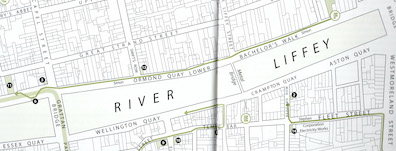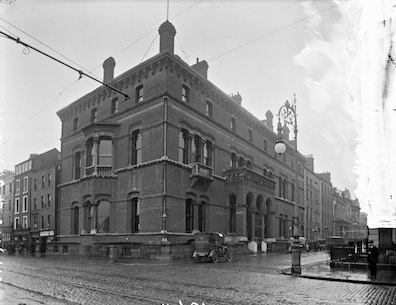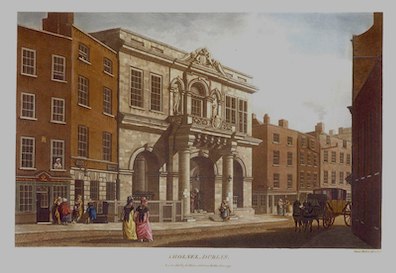Simon Dedalus and Bob Cowley run into one another "outside
Reddy and Daughter's," an antiques shop run by one
Richard Reddy at 19 Ormond Quay Lower. Dedalus has been
walking upstream along the quays from Dillon's
and is now between the Ha'penny Bridge and the Essex (or
Grattan) Bridge. Hearing that Cowley is waiting to meet Ben
Dollard, who has promised to go with him to the subsheriff's
office to help fend off Reuben J. Dodd's men, Simon scans the
area and spots Dollard crossing the metal bridge. After some
banter Dollard says, "Come along with me to the
subsheriff's office," and the three men head west toward
this office at 30 Ormond Quay Upper.
Section 19 will show, however, that Simon does not get that
far west. Near the Essex Bridge he visits a greenhouse
to empty his bladder, no doubt plagued by excessive drinking
at the Oval,
and on exiting the urinal he finds his progress interrupted by
the viceregal cavalcade moving along the quay. Early in the
next chapter he enters the bar of the Ormond Hotel at 8-9
Ormond Quay Upper without his two companions. They enter the
bar a bit later in Sirens, perhaps having arranged to
meet Simon there after visiting the subsheriff without him, or
perhaps guessing that the prospect of another drink has
waylaid him from his intended course.
After Cowley asks Dollard, "And how is that basso
profondo, Benjamin?," there is an interpolation: "Cashel
Boyle O'Connor Fitzmaurice Tisdall Farrell, murmuring,
glassyeyed, strode past the Kildare street club." This
is one of only three interpolations in Wandering Rocks
for which the estimable Clive Hart cannot discern a thematic
counterpart in the primary scene, but there are some linkages
to explore. Both Dollard and Farrell give voice to striking
noncommunicative utterances. After the interpolation Dollard
booms out a deep note: "Aw!" In section 17, "With ratsteeth
bared," Farrell mutters "Coactus volui" and strides on,
"grinding his fierce word." The Latin phrase––"Having been
forced, I was willing"––concerns legal contracts entered into
by force and fear. If Farrell is in the grip of some crushing
legal entanglement, then he resembles Father Cowley, who is
being pressed by two different creditors for payment legally
due them. And if Farrell's "fierce word" expresses defiance of
ineluctable law, that analogue colors the "Aw!" of section 14.
Dollard has come to put heart in a friend ground down by money
troubles, and his deep bass, still potent despite
poverty and ill health, sounds a clarion call of
courage.
A second interpolation comes shortly later, just after Cowley
affirms that the trombone is still in fine form and just
before a confident Dollard says, "Come along with me to the
subsheriff's office." Now appears one of the two men to whom
Cowley owes money: "The reverend Hugh C. Love walked from
the old chapterhouse of saint Mary's abbey past James and
Charles Kennedy's, rectifiers, attended by Geraldines tall
and personable, towards the Tholsel beyond the ford of
hurdles." The connection is straightforward: though
unaware of one another, creditor and debtor are quite close
and possibly about to cross paths. After leaving the chapter
house in section 8, the Reverend Love has walked east on
Mary's Abbey and reached the corner of Capel Street, where
James and Charles Kennedy, "rectifiers and whosesale wine and
spirit merchants," had a shop (31-32 Mary's Abbey, 150-51
Capel Street). Love is now heading south on Capel toward
Ormond Quay, while Crowley and his companions are heading west
on Ormond Quay toward Capel. This narrative intrusion, then,
is barely an interpolation at all. Like the glimpse of Father
Conmee in section
2, its action nearly falls within the scope of the
primary scene.
Several more geographical signifiers attach to the
history-minded Love, all of them from the past. Ben Dollard
tells Crowley, "The landlord has the prior claim. I gave him
all the particulars. 29 Windsor avenue. Love is the
name?" Cowley says, "That's right.... The reverend Mr Love.
He's a minister in the country somewhere." Ellmann notes that
for parts of 1898 and 1899 the Joyce family lived at 29
Windsor Avenue in Fairview, on the northeastern edge of Dublin
(68). In addition to this Joycean history, the interpolation
evokes bygone Dublin geography. Mulling stories of the Geraldines
in the 15th and 16th centuries, Love heads "towards the
Tholsel," a major civic building of the 14th century
that was rebuilt in the 17th and 18th centuries and demolished
in the early 19th. It stood to the southwest in Skinner's Row
(now Christchurch Place), on the other side of the river in
south central Dublin. The "ford of the hurdles" was an
ancient fording spot before Dublin had any bridges, west of
Love's present location. Dublin's Irish name, Baile Átha
Cliath, means the Place of the Ford of the Hurdles.
Section 14 continues a long series of sections that bounce
back and forth between the northern and southern banks of the
Liffey. Section 7 takes place less than one block south of the
river on D'Olier
Street. Section 8 jumps across the river and far to the
west, visiting St. Mary's Abbey a block
from the northern quays. Section 9 goes back to the south
bank, starting a little to the southeast at Crampton
Court and moving up to Wellington Quay. Section 10
takes place on that quay. Section 11 jumps to the northern
quays, two or three blocks to the east on Bachelor's
Walk. Section 12 crosses the water again, this time even
farther to the west, starting a few blocks south of the river
near James's
Gate and ending in view of the quays. Section 13 stays
on the south bank but moves far east to a street near Aston
Quay, just across the river from Bachelor's Walk.
Section 14 again jumps to the northern quays, this time west
of the Ha'penny Bridge.
Sections 5-6 and 15-18 take readers to places not much
farther from the Liffey, but with the possible exception of
number 15 they do not seem to fit the pattern. All of them are
set in the southeast quadrant of Dublin, several blocks away
from the river, and all cluster quite near the route of the
viceregal cavalcade in section 19. That procession, after
following the northern quays from Phoenix Park eastward,
crosses the river at the Essex Bridge, passes by Dublin
Castle, and then moves east along Dame Street and southeast on
Nassau Street. Its proximity to every scene in sections 5-6
and 15-18 would seem to sketch a different kind of
geographical pattern.





